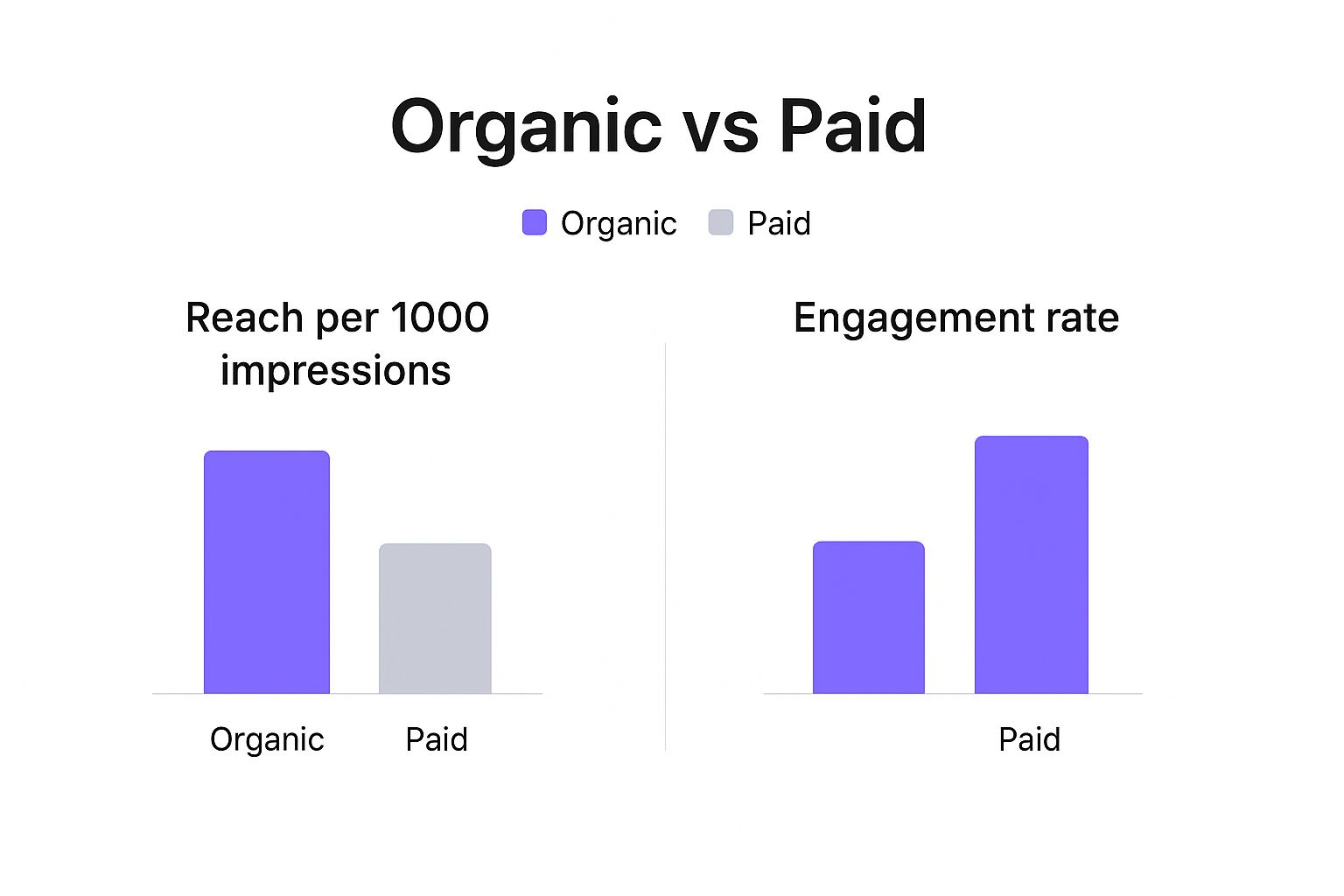Content Marketing for Startups: Essential Guide to Grow Your Business

In a market saturated with established giants, you can’t outspend your way to the top. The real secret to competing isn’t a bigger ad budget—it’s smarter content. For any early-stage company, content marketing is the most sustainable path to real growth. It’s how you build critical trust when your brand is just a name and generate high-intent leads far more effectively than burning cash on paid channels.
Why Content Is Your Startup’s Secret Weapon
Too many founders dismiss content as a “nice-to-have,” something to get to after the product is perfect or the next funding round closes. That’s a massive mistake.
The truth is, content marketing for startups is a foundational growth engine, not just another line item in the marketing budget. It's the most powerful tool in your arsenal for building a brand from the ground up, carving out a niche in a noisy market, and connecting with customers like a human, not a corporation.
Unlike paid ads that vanish the second you turn off the spend, content is an asset that works for you long-term. A single, well-researched blog post can pull in organic traffic, educate potential buyers, and generate leads for years. Think of every article or case study as a digital salesperson, working 24/7. That compounding return is exactly what a resource-strapped startup needs to survive and thrive.
Build Trust Before the Sale
As a new company, you start with zero trust capital. Potential customers have no idea who you are, what you’re about, or if your product actually works. This is why aggressive sales pitches and flashy ads often fall flat—they demand a transaction before earning any trust.
Content flips the script. It lets you prove your expertise without asking for a single thing in return. By consistently sharing valuable insights that solve your audience’s real problems, you build a relationship grounded in credibility. The sale becomes a natural next step, not a hard pitch.
This is how a tiny SaaS startup can outmaneuver an industry behemoth. While the big corporation is busy pushing generic product features, the startup is publishing in-depth guides that solve a very specific, painful problem for their ideal customer. When it’s time to buy, who do you think that customer is going to trust?
Drive Sustainable Growth and Investor Confidence
Great content doesn’t just live in the marketing department; its impact ripples across the entire business.
- Smarter Customer Acquisition: It attracts high-intent prospects through search and social media, which means you’re less reliant on expensive ads. Over time, this systematically drives down your customer acquisition cost (CAC).
- Stronger Investor Relations: A library of insightful content is proof to investors that you understand your market inside and out. It shows you have a scalable plan to attract customers, not just a cool product.
- Better Product Feedback: When you create content, you create conversations. Engaging with your audience gives you a direct line to their needs, helping you build a product roadmap based on what users actually want.
This isn’t just a hunch; it’s a massive market shift. The global content marketing industry was valued at around $413.2 billion in 2022 and is projected to keep growing at a staggering rate. If you want to dig into the numbers behind this explosive growth, you can explore the market statistics on Reboot Online. This isn't just a fleeting trend; it’s a fundamental change in how modern businesses are built, making it an essential investment for any ambitious startup.
Before diving into creating content, it's crucial to understand how different types of content align with the challenges startups face every day. Each "pillar" of content marketing serves a distinct purpose, from building initial awareness to driving sales and retaining customers.
Here's a quick breakdown of how these pillars directly address common startup hurdles:
Matching Content Pillars to Startup Challenges
| Core Pillar | Startup Challenge Addressed | Primary Goal |
|---|---|---|
| Brand Awareness | Being unknown in a crowded market | Build name recognition and trust |
| Lead Generation | High customer acquisition costs (CAC) | Attract qualified prospects affordably |
| Thought Leadership | Lack of authority and credibility | Establish expertise and become the go-to source |
| Product Marketing | Difficulty explaining a new solution | Showcase features and solve user problems |
| Customer Retention | High churn and low user engagement | Increase loyalty and lifetime value (LTV) |
As the table shows, a well-rounded content strategy isn't just about writing blog posts. It's a strategic approach to solving core business problems. By aligning your content efforts with these pillars, you can build a powerful engine for sustainable growth.
Building Your Content Strategy on a Lean Budget

A powerful content marketing strategy isn't built on a huge budget. It's built on a deep, almost obsessive, understanding of your customer. For a startup, this is your secret weapon. You don’t need to outspend your competitors when you can out-think them by being resourceful, specific, and completely customer-focused from day one.
Lots of startups burn through their limited cash trying to be everything to everyone. The result? Thin, generic content that speaks to no one. A much smarter approach is to focus your efforts with surgical precision. This all starts by going beyond basic demographics to build a truly insightful ideal customer profile (ICP).
Define Your Ideal Customer Profile
Your ICP is so much more than an age range and a job title. Think of it as a living, breathing document that captures the real-world headaches, goals, and habits of the person you exist to help. To build an ICP that actually works, you need to get answers to some critical questions.
- What are their biggest professional pain points? Go deeper than the surface-level stuff. What’s the specific problem that keeps them up at night—the one your product or service is perfectly built to solve?
- Where do they look for information? Are they binging industry podcasts, scrolling through niche Slack communities, or reading specific blogs? That’s exactly where your content needs to show up.
- What language do they use? Listen closely to the exact words and phrases they use to talk about their problems. This is pure gold for both your content and your SEO.
A great ICP is your north star for every single content decision. If a piece of content doesn't speak directly to their needs or show up in a channel they actually use, you shouldn't create it. It’s that simple.
For instance, instead of targeting "small business owners," a startup with accounting software could zero in on "solo freelance graphic designers earning $50-80k who struggle with quarterly tax estimates and client invoicing." That level of detail instantly tells you what to create and where to share it.
Find Your Content Gaps with Competitor Analysis
Once you know exactly who you're talking to, it's time to see what your competitors are up to. The goal isn't to copy them—it's to find the gaps they've left wide open for you to own. Your lean budget is an asset here, forcing you to get creative and find those uncontested spaces.
Start by listing three to five of your closest competitors, both direct and indirect. Then, dive into their content with a specific mission:
- What topics are they covering to death? Make a note of these. You might need to touch on them eventually, but they're likely super competitive and will burn through your resources fast.
- What topics are they barely touching? Look for areas where their content is thin, outdated, or way too generic. This is your low-hanging fruit.
- What content formats are they ignoring? If everyone is writing blog posts, maybe your big opportunity is in short-form video tutorials, a niche podcast, or practical templates.
A SaaS startup might discover that all its rivals have blog posts on "Project Management Tips," but none have a practical guide on "Managing a Hybrid Creative Team's Workflow." That specific, underserved topic is the perfect content gap to fill.
Demystify Your Keyword Research
Keyword research sounds intimidating, but for a startup, it's really about finding realistic opportunities, not chasing the most popular (and competitive) terms. You're hunting for the phrases your very specific ICP is typing into Google when they need a solution.
Think about the search funnel. Top-of-funnel (TOFU) keywords are broad and informational, like "how to improve team productivity." Bottom-of-funnel (BOFU) keywords, on the other hand, are transactional and signal purchase intent, like "best project management tool for startups."
As a startup, you'll want a mix, but your sweet spot is long-tail keywords. These are longer, more specific phrases that have lower search volume but much higher conversion intent. Someone searching for "Trello vs Asana" is just window shopping. But a person searching for "how to integrate Slack with Asana for a remote team" has a specific, urgent problem they need to solve right now. That's your customer.
By combining a razor-sharp ICP, smart competitor analysis, and targeted keyword research, you're laying the groundwork for a content strategy that drives real results. This focused approach ensures every piece of content you create serves a purpose, moving your startup closer to its goals without wasting a single dollar or hour.
How to Create Content That Actually Converts

Anyone can fill a blog with words. The real challenge—and where the money is made—is creating content that actually gets a reader to do something. Sign up. Download. Buy. That’s the stuff that turns an audience into a business. For a startup, this isn't just a nice-to-have; it's how you unlock the true power of content marketing.
Look, effective content isn't about just yelling about your features. It's about showing up at the right time, in the right place, with the exact piece of information your audience needs to take the next step. This means you need to get smart about matching your content format to the moment.
Match Your Content Format to the Funnel
The marketing funnel isn't some abstract concept—it's a practical roadmap. Someone just discovering they have a problem needs something very different from someone who's one click away from buying.
- Top of Funnel (Awareness): People at this stage are aware of their problem, not your solution. They're typing questions into Google, looking for answers, not products. Your goal here is to educate and build trust, not to sell.
- Best Formats: How-to blog posts, explainer videos, infographics, and reports on industry trends are gold here. They offer real value without a hard pitch. For instance, a fintech startup might publish a post like, "5 Common Invoicing Mistakes That Cost Freelancers Thousands."
- Middle of Funnel (Consideration): Okay, now they know you exist. They're weighing their options and trying to figure out the best way to solve their problem. This is your chance to really show off your expertise and prove your approach is superior.
- Best Formats: Detailed case studies, comparison guides ("Our Tool vs. The Old Way"), and webinars work perfectly. These formats let you showcase tangible results and tackle objections head-on.
- Bottom of Funnel (Decision): They’re ready to pull the trigger. They just need that last little nudge of confidence to choose you over everyone else.
- Best Formats: Customer testimonials, in-depth product demos, and free trial landing pages are your closers. This content is all about making the final decision feel safe, easy, and obvious.
When you align your content with the user's journey, you create a smooth, natural path from "Who are you?" to "Take my money!"
Find a Memorable Brand Voice
In a world drowning in corporate-speak and bland blog posts, a distinctive brand voice is a startup's secret weapon. It’s what makes you stick. Your voice isn’t just what you say, but how you say it.
Think about your startup's personality. Are you the witty, insightful friend? The seasoned, trustworthy expert? The scrappy, innovative disruptor? Whatever it is, that personality needs to bleed into every word you write.
Your brand voice is the consistent personality your audience comes to know, like, and trust. It turns a transactional relationship into a loyal one. Authenticity here is non-negotiable; your voice must be a genuine reflection of your company's culture and values.
For example, a project management tool for creative agencies could adopt a playful, encouraging tone and use language that resonates with designers and artists. In contrast, a cybersecurity startup would likely need a direct, authoritative voice to build trust and convey security. Find your voice, and you'll find your people.
Master the Art of Storytelling and Structure
Even the most brilliant advice will fall flat if it’s delivered as a giant wall of text. The best content strikes a balance between compelling storytelling and scannable structure, satisfying both the deep readers and the skimmers.
A simple but incredibly effective storytelling framework is Problem-Agitate-Solve (PAS).
- Problem: Start by hitting the reader's pain point head-on. Make them nod and say, "That's me." ("Struggling to keep track of client feedback buried in a dozen email threads?")
- Agitate: Now, pour a little salt in the wound. Dig into the frustrations and consequences of that problem. ("It leads to missed deadlines, frustrated clients, and endless, soul-crushing revision cycles.")
- Solve: Finally, present your solution—your advice or your product—as the clear, obvious way to make the pain go away. ("Here's a simple framework to centralize feedback and cut your revision time in half.")
This narrative hooks the reader emotionally and positions your solution as a welcome relief. From there, it's all about making the content easy to digest.
- Use short paragraphs. Seriously, 1-3 sentences max.
- Break up sections with clear, descriptive H3 subheadings.
- Use bullet points and numbered lists to make key information pop.
- Write irresistible headlines that promise a clear benefit. Instead of "Content Tips," try "10 Content Tips That Doubled Our Lead Flow in 60 Days."
This one-two punch of storytelling and smart formatting ensures your message doesn’t just get read—it gets acted on. And that's how you turn passive readers into the active, engaged customers your startup needs to grow.
Amplifying Your Reach with Smart Distribution
Creating brilliant content is only half the battle. Seriously. If that perfectly crafted article or insightful case study just sits on your blog gathering digital dust, you’ve wasted a ton of effort. Smart, strategic distribution is what separates content that gets seen from content that disappears. For a startup, this isn't about having a huge ad budget; it's about being scrappy and out-thinking the competition.
Instead of just hitting "publish" and praying for traffic, you need to build a multi-channel distribution engine. It’s about getting your content in front of the right eyeballs—on social media, in their inboxes, and inside the online communities where they already hang out.
Tapping into Your Owned Channels
Your most valuable distribution channels are the ones you control directly. These are your foundational platforms for building a loyal, engaged audience that actually wants to hear from you. Think of these as your home turf.
First up, your email newsletter. This is gold. It's a direct line to people who have already raised their hands and shown interest. Don't just dump a link in there. Frame it with a personal insight or a compelling question that makes them want to click.
Next are your primary social media channels. But don't just mindlessly broadcast links. Each platform has its own language and you need to speak it fluently.
- On LinkedIn: Pull a thought-provoking takeaway from your article and tag relevant experts or companies you mentioned to spark a conversation.
- On X (formerly Twitter): Break down the key points of your post into a bite-sized, shareable thread. Make it easy for people to digest and retweet.
- On Instagram: Use a visually striking image or a short video clip to tease the content and drive traffic from your bio link.
The key here is to repackage, not just regurgitate. Each social post should feel native to the platform, adding value on its own while inviting your followers to go deeper by reading the full piece.
Earning Reach in Online Communities
Beyond your own channels lies a huge landscape of earned media opportunities. This is where you find your ideal customers hanging out—in niche forums, Slack groups, and Reddit communities. But tread carefully here. Blatant self-promotion is the fastest way to get yourself banned and torch your reputation.
Your approach has to be value-first. Period. Before you even think about sharing a link to your content, become a genuine member of the community.
Engage in discussions. Answer questions. Offer help. Once you've established yourself as a credible, helpful voice, you'll earn the right to share your content when it’s genuinely relevant to a conversation. Always frame it as a helpful resource, not a promotion.
This strategy builds real trust and drives highly qualified traffic. I've seen a single, well-placed link in a relevant Reddit thread outperform a week's worth of generic social media blasts. It’s about being a participant, not a marketer.
Leveraging Smart Promotion Tactics
Organic efforts are the bedrock of distribution, but a little strategic, targeted promotion can give your most important content a massive boost. This isn't about outspending everyone; it's about working smarter with the budget you have.
You can see where the industry is heading. Recent B2B investment trends show that 61% of marketers are boosting their spend on video content, 52% on thought leadership, and 40% on AI for content optimization. This signals a clear move toward higher-quality, more engaging formats—a trend that savvy startups can ride to gain an edge, especially in North America. You can dive deeper into the latest content investment trends on Statista.
This infographic really brings to life the difference between organic reach and the initial burst you get from paid promotion.

As you can see, while paid channels can guarantee that initial visibility, it's the organic content that often builds deeper, more meaningful engagement over the long haul.
A great distribution strategy balances both. You need to decide which channels are the best fit for your team's resources and goals.
Choosing Your Startup's Content Distribution Channels
Picking the right channels can feel overwhelming. To make it easier, here's a quick breakdown to help you decide where to focus your energy for the best return.
| Channel | Best For | Effort Level | Potential ROI |
|---|---|---|---|
| Email Newsletter | Nurturing leads and building long-term loyalty with an interested audience. | Low to Medium | High |
| Social Media (Organic) | Building brand awareness and community engagement. | Medium | Medium to High |
| Online Communities | Driving highly-qualified traffic and building authority. | High | Very High |
| Paid Social Ads | Targeting specific demographics and getting immediate visibility for key content. | Medium | Medium |
| SEO & Blog | Creating a long-term asset that generates consistent, organic traffic. | High | Very High |
Every startup's mix will be different. The goal isn't to be everywhere, but to be highly effective on the channels that matter most to your audience.
And this is where modern tools can give you an unfair advantage. For example, MakerBox can help you sharpen headlines and optimize your social media posts for maximum impact, ensuring every dollar of your promotion budget goes further.
By combining a strong organic foundation with targeted, intelligent promotion, you create a powerful system. It’s a system that ensures your best content doesn't just get created—it gets seen by the people who matter.
Measuring Performance and Optimizing for Growth

Creating great content is a fantastic start, but let's be honest: how do you know if it's actually working? For a startup, every hour and dollar spent needs to have a purpose. This is where measurement comes in—and I’m not talking about chasing vanity metrics like social media likes. It’s about focusing on the key performance indicators (KPIs) that signal real business growth.
The goal is to ditch the "publish and pray" mentality for a data-driven feedback loop. This simple shift can transform your content marketing from a guessing game into a predictable engine for growth. You need to get under the hood, understand what resonates with your audience, what falls flat, and then use those insights to make smarter decisions.
Focusing on Metrics That Matter
It’s easy to get lost in a sea of data. Instead of trying to track every little thing, zero in on the numbers that draw a straight line from your content to your startup's biggest goals, like generating leads or acquiring customers.
Here are the essential metrics every startup should be watching:
- Organic Traffic and Keyword Rankings: This is your bread and butter. It shows if your SEO efforts are actually drawing new people from search engines. A steady climb in organic traffic is a clear sign your content is gaining authority and visibility.
- Lead Conversion Rate: Are visitors actually taking the next step? This could be signing up for your newsletter, downloading a guide, or requesting a demo. This metric tells you if your content is persuasive enough to turn passive readers into engaged prospects.
- Customer Acquisition Cost (CAC): This is a core metric for any startup. Tracking CAC from your content channels helps you prove its ROI. As your content engine matures, you should see your content-driven CAC drop, making it a far more efficient growth channel than paid ads.
The most successful startups don't just create content; they obsess over its performance. They treat every article and video as an experiment, constantly testing, learning, and optimizing to improve results. This mindset is what turns a blog into a powerful business asset.
Imagine this scenario: a B2B SaaS startup notices a blog post comparing two competing methodologies drives a ton of organic traffic, but almost no one converts. Instead of shrugging it off, they add a downloadable template related to the topic. Boom—sign-ups from that single post skyrocket. That's optimization in action.
Performing a Regular Content Audit
Your existing content is a goldmine of opportunity. Over time, some pieces will become outdated, while others might be quiet performers you can squeeze even more value from. A regular content audit—maybe quarterly or semi-annually—is your key to keeping your content library fresh and effective.
The process doesn't need to be a huge headache. Just create a simple spreadsheet listing your key content assets and track metrics like traffic, backlinks, and conversion rates. Then, give each piece a job to do:
- Keep: The content is a solid performer and still relevant. Leave it be.
- Update: The topic is valuable, but the content is getting stale. This is your chance to add new data, examples, or visuals to give it a second life.
- Repurpose: A high-performing blog post could become a video, an infographic, or a webinar. This extends the reach of your best ideas without starting from scratch.
- Consolidate: Got multiple weak posts on the same topic? Combine them into one comprehensive, authoritative guide. This often performs much better in search results.
- Delete: Some content is just plain irrelevant or low-quality. It's better to remove it and redirect the URL to a more valuable page.
The Power of AI in Content Optimization
Continuously optimizing content can feel like a full-time job, but modern tools are changing the game. AI is making a huge impact on content marketing, with around 65% of companies reporting better SEO results after bringing AI into their workflow. To stay competitive, startups need to embrace these tools. You can dig into more stats about the impact of AI on content marketing to see just how fast this trend is moving.
Tools like MakerBox can automate big parts of this optimization process. It can analyze your existing content to suggest stronger headlines, spot opportunities for keyword improvements, and even help you repurpose articles for different social media channels. It’s all about making sure you get the maximum ROI from every single asset you create.
Common Questions About Startup Content Marketing
Diving into content marketing always kicks up a storm of questions. Founders and marketers, especially in the early stages, need clear, no-nonsense answers to get past the initial hurdles and build a strategy that actually works. We hear the same questions over and over, so let's tackle them head-on with some straightforward advice.
How Soon Can a Startup Expect to See Results?
This is the big one, isn't it? The honest answer: content marketing is a marathon, not a sprint. You'll need to set your expectations accordingly.
You might spot some early green shoots within the first 1-3 months—a nice little bump in social engagement or a bit more direct traffic to your site. But the results that really move the needle, like a reliable flow of organic leads or ranking on Google's first page, typically take 6-12 months of consistent, high-quality work. Patience is an absolute must.
The trick is to focus on leading indicators early on. Keep an eye on your keyword rankings inching up, more newsletter sign-ups, and people spending more time on your pages. These are the small wins that prove you're on the right track long before the big results roll in.
Think of it like planting a tree. You don't get shade overnight. But if you water it consistently, you'll see it grow stronger and taller, week by week.
Should a Startup Focus on Content Quantity or Quality?
When you're a startup with limited time and money, the answer is always the same: quality over quantity, every single time.
One deeply researched, genuinely helpful article that solves a real problem for your ideal customer is worth more than five generic, rushed blog posts. High-quality content is what builds trust. It’s what earns those precious backlinks, ranks higher in search engines, and cements your startup as the go-to expert in your space.
Once you’ve nailed a process for creating truly excellent content—and you know exactly what "good" means for your audience—then you can start thinking about picking up the pace. But never, ever sacrifice quality just to hit a publishing target. It's a trade-off that will bite you in the long run.
How Do I Create Content If I'm Not a Great Writer?
So many brilliant founders and experts aren't natural-born writers. And that's completely okay. Your real asset isn't your prose; it's your deep, hard-won expertise.
Lean into what you know best. Here are a few practical ways to get your knowledge out there without being a wordsmith:
- Just Talk It Out: Grab your phone, hit record, and just talk about a topic you know inside and out. Explain it like you would to a customer. You can then use a transcription service to turn that recording into a rough draft for a writer or an AI tool to polish.
- Lean on Frameworks: You don't have to start from a blank page. Use proven content structures like "Problem-Agitate-Solve" or simple listicles to give your thoughts a logical flow.
- Think Beyond Writing: Who says content has to be written? Your insights might be a perfect fit for a podcast, a quick video tutorial, or a sharp-looking infographic.
AI writing assistants can be a huge help here, especially for creating outlines and cleaning up drafts. But always remember the final, most important step: a human expert (that's you!) needs to edit the final piece to add those unique insights, personal stories, and authentic voice that only you can provide.
Should Our Founder Be the Face of Our Content?
Having the founder lead the content charge can be a massive advantage for a startup. It injects a level of authenticity, personality, and human connection that big, faceless corporations can only dream of. A founder’s voice builds instant credibility.
But here's the catch: relying only on the founder can create a huge bottleneck. If every single blog post or social update needs the founder’s direct touch, you’ll never be able to scale.
The best approach is usually a balanced one. Use the founder for high-impact activities where their voice is most powerful—think hosting a webinar, writing a big-picture thought leadership piece, or appearing on a top industry podcast.
At the same time, build a separate, scalable process for creating the day-to-day content like blog posts, social media updates, and case studies. This hybrid model gives you the best of both worlds: the founder's authentic authority and a content engine that can run on its own.
Ready to turn your expertise into a powerful online presence? MakerBox uses AI to help you create optimized social media bios, posts, and professional profile images in seconds. Stop guessing and start growing. Elevate your professional brand with MakerBox today.





